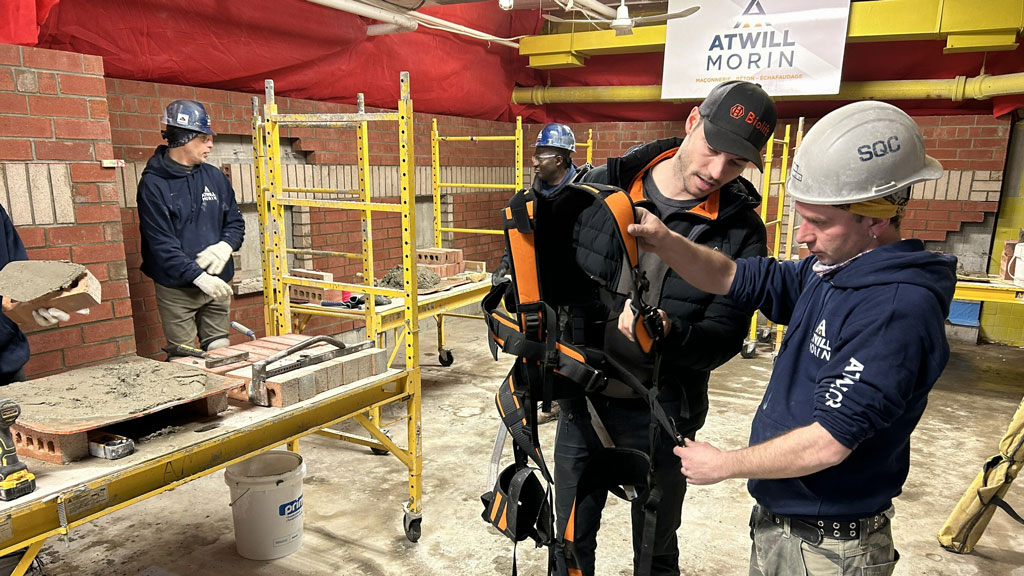Quebec-based construction company Atwill-Morin has acquired a dozen exoskeletons for its workers to wear on key projects, boosting strength exponentially for tasks requiring heavy lifting and increasing worker safety and productivity.
The lightweight suits are being used on a hotel restoration project in Quebec City, among others, where workers are dismantling half-century-old stone walls and moving the blocks for repair.
Use of the exoskeletons, which have a supportive infrastructure relying on springs, has the effect of increasing workers’ strength almost tenfold, reducing around 70 per cent of the load being handled, says the firm.
“We want to innovate in order to be different from other contractors that are in the same trade,” said CEO Matthew Atwill-Morin. “We want to offer the opportunity to be more productive while being safe and while managing their well-being, their bodies, all aspects of their physical and ultimately mental health also.”
Back injuries a plague
Exoskeletons are designed to address work-related musculoskeletal disorders (WMSDs) in jobs where there is repetitive work, heavy and awkward lifting and prolonged tasks.
Use of the suits makes heavy objects easier to carry and move, reduces wear and tear on ligaments, muscles and the back, and limits over-exertion.
A report from the Center for Construction Research and Training stated the back remains the primary body part affected by WMSDs in construction.
Atwill-Morin said not only will injuries and fatigue be reduced over the course of a year, but the firm is looking at the long-term health of its employees.
“It will prevent the issues that we may have once or a couple of times a year,” he said. “But I see that we’ll probably be able to prolong the career and most definitely have a better retirement, or even be able to stay within the industry a longer time to actually be able to do the job that they love.”
Exoskeletons evolving
Atwill-Morin said he and his brothers travel the world looking for innovations and they have observed exoskeleton technology improving.
The firm uses suits manufactured by Fraco, a Quebec firm, but other manufacturers such as Hilti are also making good equipment, said Atwill-Morin.
The CEO said exoskeletons are in the second phase of their development, becoming lighter and more versatile.
The construction sector only started adopting the technology about 10 years ago and Atwill-Morin first engaged in it about five years ago.
The cost per suit is between $2,000 to $15,000 and the firm wants to continue to expand use, especially given that generation three promises to be even lighter, stronger and more adaptable.
Currently, the suits can still be ergonomically awkward, Atwill-Morin said. And there are workplace cultural barriers to overcome.
“Our biggest challenge right now is to change the mentality of our colleagues onsite for them to use this new equipment,” he said. “We’re talking about hard-working men and women that have been doing things in a specific way for years, decades. Some of them have done 30,000, 40,000 hours on construction sites and don’t feel that they need this.”
The younger generation is quicker on the uptake, said Atwill-Morin.
“That’s up to us to keep on training them, keeping them available, keeping them maintained. And also to educate them so that they understand that we’re doing this for them.”
Besides physical benefits, with fitter workers staying on the job longer and contributing to productivity, the firm said, workers using the exoskeleton avoid chronic pain and the potential slide into mental health problems associated with addictions.
For users, the feedback is very positive.
“Those that carry around the brick and mortar and the stone, at the end of their day, they’re not tired…they are saying, ‘At the end of the day, when I get in my car, I can still bend over and lace my shoes.’”
Follow the author on Twitter @DonWall_DCN.




Recent Comments